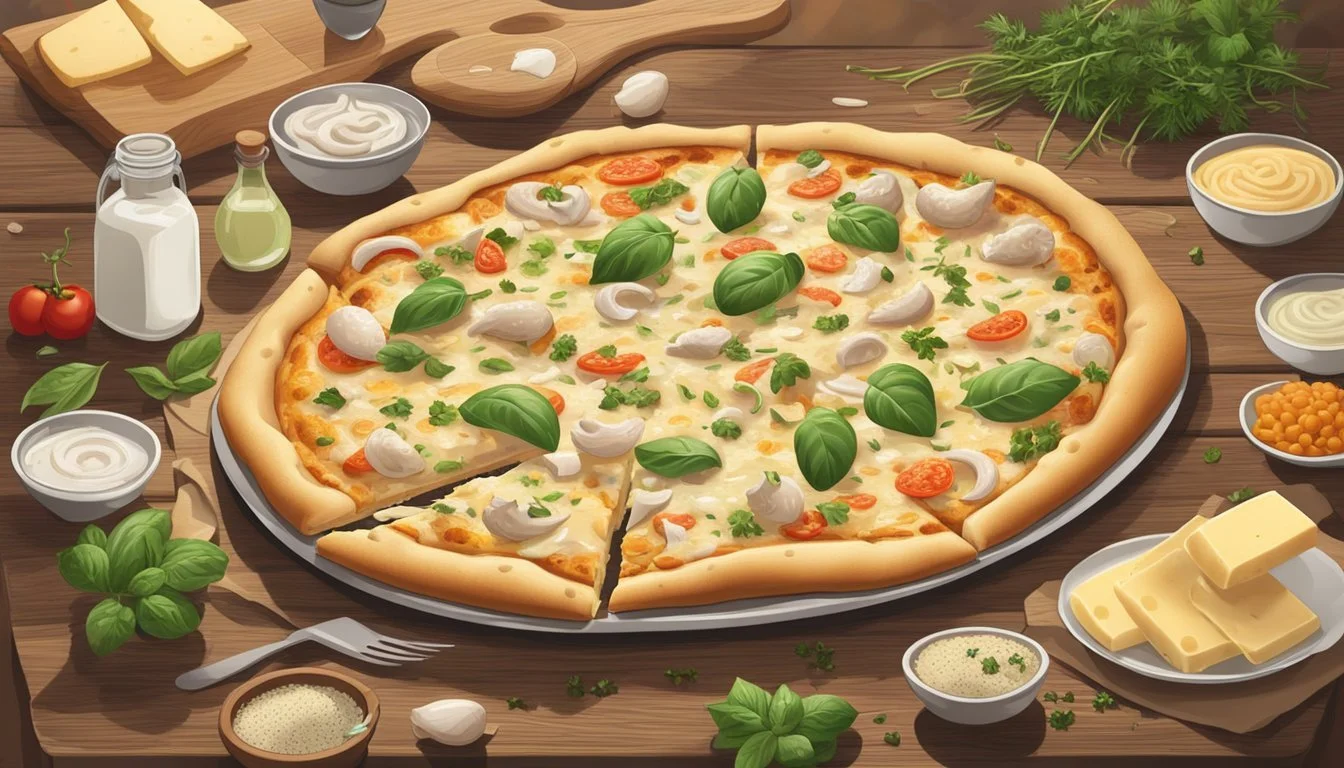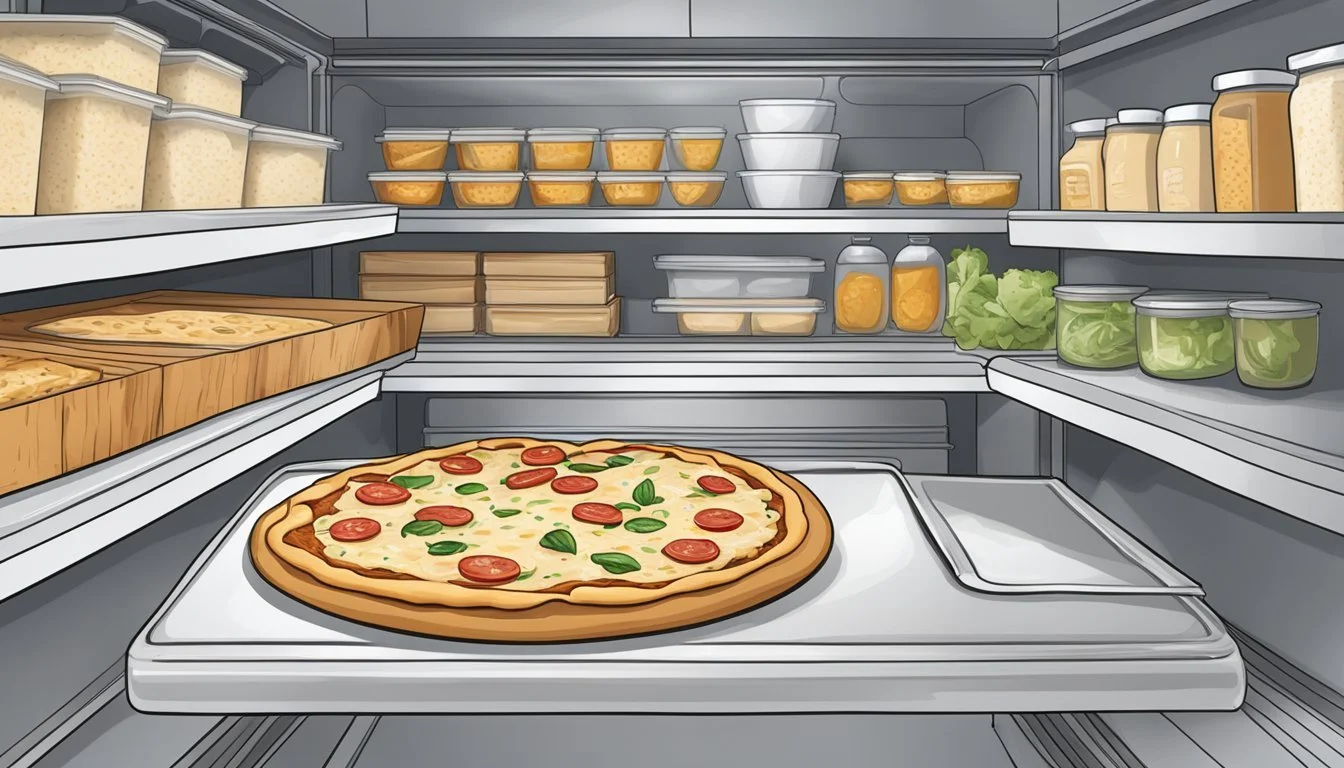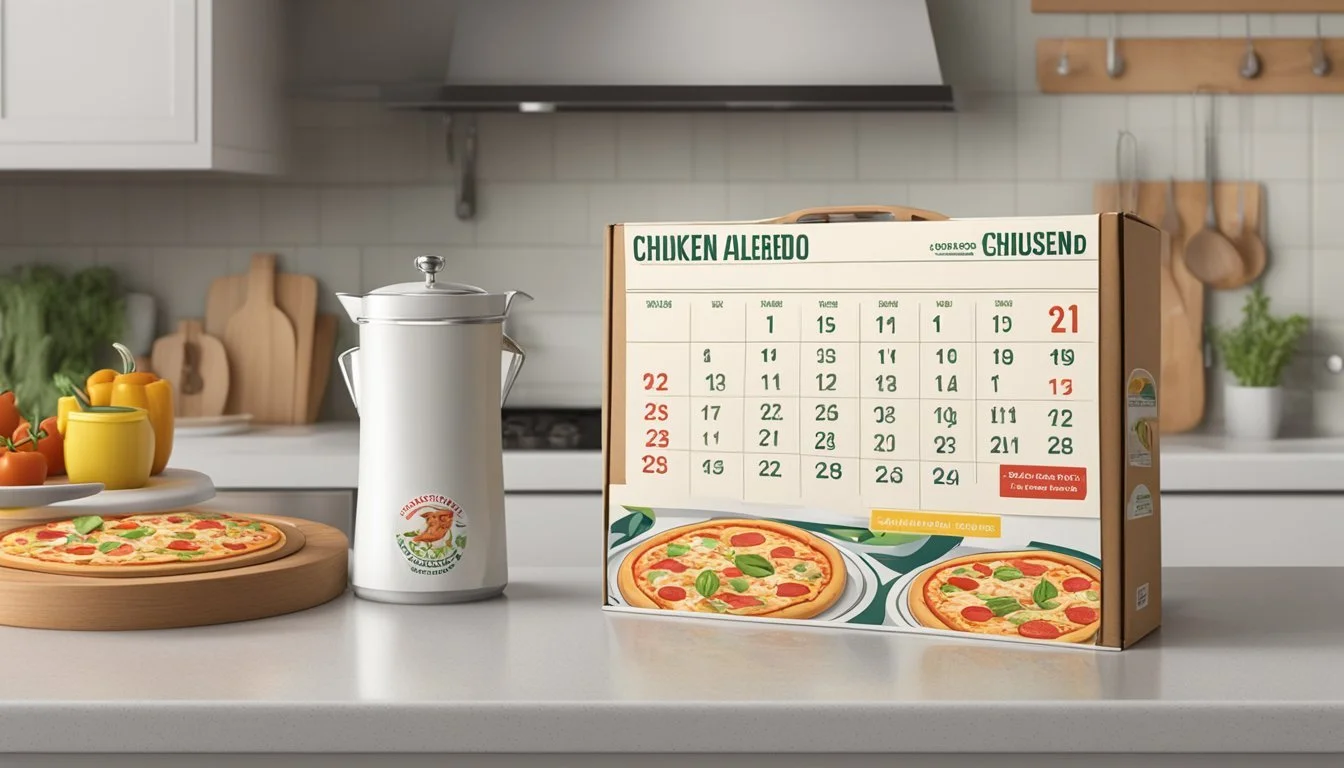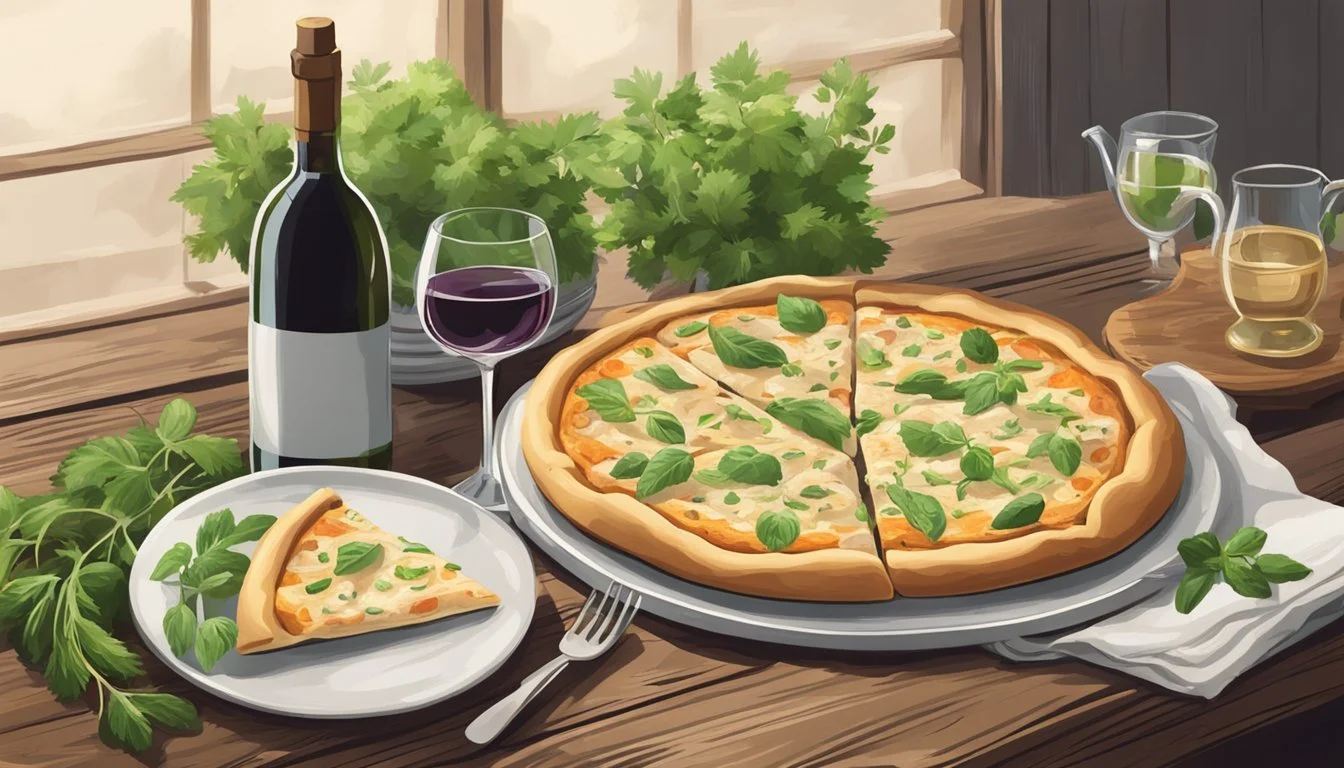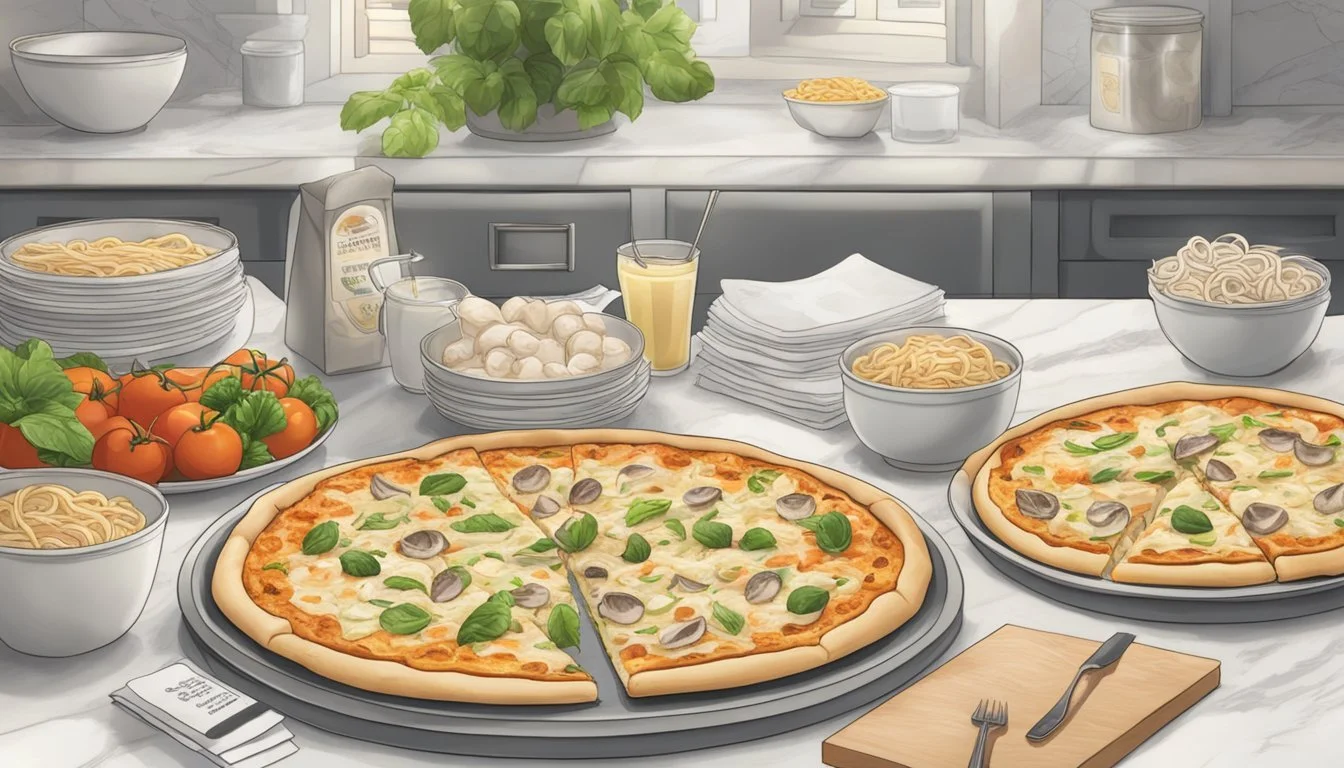How Long Does Chicken Alfredo Pizza Last
Storage Tips and Shelf Life
Chicken Alfredo Pizza combines the rich, creamy goodness of Alfredo sauce with delicious chicken on a crispy pizza crust. While savoring this delightful dish, many wonder about its shelf life and how long they can safely enjoy their leftovers.
Chicken Alfredo Pizza typically lasts for 3 to 4 days when stored properly in the refrigerator. It's crucial to keep the pizza in an airtight container to maintain its freshness and prevent any bacterial growth. Always ensure that the pizza is completely cooled before sealing it to avoid condensation.
For those looking to extend the lifespan of their Chicken Alfredo Pizza, freezing is an excellent option. Properly wrapped, the pizza can be stored in the freezer for up to 1 to 2 months. When reheating, make sure it reaches a safe temperature to enjoy a meal that's as delightful as the first bite.
Overview of Chicken Alfredo Pizza
Chicken Alfredo Pizza is a flavorful and comforting Italian dish ideal for lunch or dinner.
This pizza starts with a creamy Alfredo sauce spread over the pizza crust. The sauce is typically made from butter, garlic, heavy cream, and parmesan cheese.
Next, cooked chicken is scattered over the sauce. This ingredient adds protein and enhances the savory flavor profile.
Cheese such as mozzarella and parmesan is then added generously. These cheeses create a gooey, melted topping that complements the Alfredo sauce.
Various toppings can be included to customize the pizza. Sliced red onions, spinach, or even mushrooms can enhance the dish.
The pizza is baked until the crust is golden and the cheese is melted and bubbly.
This versatile dish can be enjoyed as part of a menu at gatherings or as a comforting meal on a cozy night in. This pizza combines the best elements of both pasta and pizza, making it a unique addition to any dining experience.
Essential Ingredients
When making Chicken Alfredo Pizza, selecting fresh, high-quality ingredients is crucial. This ensures a rich flavor and enhances the overall dish.
Fresh Chicken
Using fresh chicken is vital for the best taste and texture. Opt for chicken breasts, as they are lean and cook quickly. Thighs also work well, providing a richer flavor.
Season the chicken with salt, pepper, and garlic before cooking. This seasoning brings out the natural flavors and complements the Alfredo sauce. For a twist, bacon bits or spices can add extra depth.
Keys to the Perfect Alfredo Sauce
A good Alfredo sauce starts with the right ingredients. Use butter, heavy cream, and Parmesan cheese for a creamy, rich base. Fresh garlic should be sautéed in olive oil to enhance the flavor profile.
Cook the sauce over low heat to avoid separating. Consistent stirring helps maintain a smooth texture. Season with a pinch of salt and pepper to taste, adjusting as needed for balance.
Selecting Cheese and Toppings
The choice of cheese and toppings significantly affects the overall pizza flavor. Mozzarella melts beautifully, providing a gooey texture. Combine it with Parmesan cheese for a sharper flavor.
Fresh herbs like basil or parsley can be added for a fragrant touch. Olive oil drizzled over the top before baking enhances the flavor. Popular toppings include bacon for a smoky taste and pineapple for a sweet contrast.
Experiment with various combinations to find your preferred mix, ensuring the balance of flavors complements the Alfredo sauce and chicken.
Preservation and Storage
To ensure chicken alfredo pizza maintains its quality and safety, proper storage techniques are crucial. This section covers guidelines for refrigerating and freezing the pizza, focusing on the specifics of each method.
Refrigerating Chicken Alfredo Pizza
Chicken alfredo pizza leftovers should be promptly refrigerated within two hours of cooking to prevent bacterial growth.
Place the pizza in airtight containers or wrap it tightly in aluminum foil or plastic wrap. This prevents moisture loss and maintains the pizza's quality.
In the refrigerator, stored at 40°F (4°C) or below, the pizza can last up to 3-4 days. Ensure the internal temperature of the fridge is consistent.
Reheat refrigerated pizza in an oven, toaster oven, or microwave. These methods ensure the pizza is heated thoroughly to an internal temperature of at least 165°F (74°C).
Freezing and Thawing Best Practices
For longer storage, freezing chicken alfredo pizza is an effective option. Allow the pizza to cool to room temperature before freezing to prevent ice crystal formation.
Wrap individual slices tightly in plastic wrap, and then place them in freezer bags or airtight containers. Label these with the date to keep track of shelf life.
Frozen pizza retains its best quality for 2-3 months. To thaw, transfer the slices to the refrigerator for several hours or overnight. Avoid thawing at room temperature, as this can promote bacterial growth.
Reheat defrosted pizza using an oven or toaster oven for best texture. If using a microwave, consider placing a cup of water inside to keep the crust from becoming too chewy.
Health and Safety Considerations
Proper food storage and handling are crucial for maintaining the quality and safety of chicken Alfredo pizza. Adhering to recommended practices can prevent foodborne illnesses and ensure the dish remains tasty.
Understanding Foodborne Risks
Chicken Alfredo pizza, like other perishable foods, requires careful handling to avoid contamination. Fresh chicken and other ingredients must be cooked to an internal temperature of 165°F (74°C) as verified by a thermometer. This ensures harmful bacteria such as Salmonella and Campylobacter are eliminated.
If the pizza is left at room temperature for more than two hours, it should be discarded. Appearance and smell can indicate spoilage—signs include discoloration, sour odors, and slimy texture.
Proper Handling Techniques
To preserve chicken Alfredo pizza, promptly refrigerate it after cooling. Store it in an airtight package or container to minimize water loss and contamination. Cooked chicken should be consumed within 3-4 days if refrigerated.
For extended storage, freezing is an option. Ensure the pizza is placed in a freezer-safe package and consumed within 2-3 months. Before serving frozen pizza, thaw it in the refrigerator and reheat to an internal temperature of 165°F (74°C) to ensure safety.
Such careful preparation and storage practices are essential for keeping chicken Alfredo pizza fresh and safe to eat.
Cooking Methods and Techniques
There are several ways to prepare Chicken Alfredo Pizza that can enhance its flavor and texture. This section will discuss baking essentials and some alternate cooking options available.
Baking Essentials
For a perfect Chicken Alfredo Pizza, start with a quality crust. A homemade crust, made with a blend of flour, yeast, water, and a pinch of salt, tends to yield the best results. Before adding toppings, pre-bake the crust for a few minutes at 425°F (220°C) to ensure it becomes crispy.
The Alfredo sauce is another key element. A homemade sauce, typically made from butter, heavy cream, and Parmesan cheese, will provide a rich and creamy base. Ensure that the sauce covers the crust evenly but isn't too thick.
Top with cooked, juicy chicken, sautéed spinach, and finely chopped cooked bacon. Use a combination of mozzarella and Parmesan cheese to enhance the flavors. Bake in the oven at the same temperature until the cheese is bubbly and golden.
Alternate Cooking Options
If an oven is unavailable, there are other methods to cook a Chicken Alfredo Pizza. Using a microwave is one quick alternative. Pre-bake the crust using microwave-safe bakeware, then assemble the pizza and cook on high for about 5-7 minutes. The texture might differ slightly, but it's a convenient option.
A grill can also serve as an effective cooking method. Preheat the grill to medium-high heat, place the dough on the grill, and cook for a few minutes on each side. After pre-cooking the crust, add the toppings and close the grill lid to melt the cheese.
Finally, a cast-iron skillet can mimic the high temperatures of a pizza oven. Heat the skillet on the stove, place the crust in, add toppings, and then transfer it to a preheated oven. This method creates a nicely charred crust with evenly melted toppings.
Reinventing Leftovers
Maximize the value of leftover chicken Alfredo pizza by transforming it into new, delicious meals. Using fresh ingredients and creative ideas, you can turn leftovers into exciting meals rather than letting them go to waste.
Creative Meal Ideas
Leftover chicken Alfredo pizza can be reinvented in several ways. One option is to create chicken salads by shredding the chicken and tossing it with fresh greens, cherry tomatoes, and a light vinaigrette.
For a heartier option, consider chicken quesadillas. Spread a bit of extra cheese and salsa on a tortilla, add the shredded chicken, and cook until crispy.
Another idea is to make chicken enchiladas. Wrap the pizza’s shredded chicken and Alfredo sauce in tortillas, cover with enchilada sauce, and bake until bubbly.
Incorporate it into a white chicken chili. Mix the shredded chicken with white beans, green chilies, and a bit of chicken broth. Let it simmer until flavors meld together.
Tips for Combining Flavors
When combining leftovers with fresh ingredients, balance flavors and textures. Fresh herbs and greens can add a crisp, refreshing contrast to the richer elements of the pizza.
Creamy dressings or sauces can complement the spiciness if you make buffalo chicken wraps using shredded chicken from the pizza.
Incorporate leftover pasta dishes by mixing in some of the shredded chicken for added protein and variety.
Use bold flavors such as garlic, lime, or cilantro to brighten up the dish and introduce a new dimension to the combined ingredients.
Adding elements like crunchy nuts or seeds can provide an interesting texture contrast. By being mindful of these tips, reinventing leftovers becomes an enjoyable and creative culinary endeavor.
Pairing and Serving Suggestions
Accompanying your Chicken Alfredo Pizza with well-chosen sides can complement and enhance the overall dining experience. Consider options like vibrant salads, flavorful pastas, and tangy sauces.
Complementary Sides
Green Salad
A fresh green salad can provide a crisp contrast to the rich and creamy Chicken Alfredo Pizza. Mixing greens like lettuce, spinach, and arugula with a light vinaigrette brings a refreshing balance. Adding toppings such as cherry tomatoes, cucumbers, and red onions enhances the salad's flavor and texture.
Roasted Vegetables
Roasted vegetables like cherry tomatoes, bell peppers, and zucchini offer a nutritious and tasty side dish. Drizzle the veggies with olive oil, sprinkle with salt, pepper, and a dash of cayenne for a touch of heat, and roast until tender. The slight caramelization complements the Alfredo sauce's creaminess.
Garlic Bread
Garlic bread is an excellent side to soak up any extra Alfredo sauce. Toast slices of bread with a mix of butter, minced garlic, and parsley. Serve hot and crispy, offering a perfect companion to the pizza's creamy and cheesy profile.
Pasta with Arrabbiata Sauce
For those who enjoy a bit of spice, pasta with Arrabbiata sauce can be a great addition. This spicy tomato-based sauce adds a fiery kick, balancing the pizza's richness. Choose short pasta shapes like penne or rigatoni to effectively hold the sauce and create a satisfying side dish.
Culinary Variations and Ideas
Chicken Alfredo pizza offers ample opportunities to infuse creativity and cater to different tastes. Through regional flavor twists and dietary adaptations, this dish can transform to suit various preferences.
Regional Flavor Twists
Incorporating regional flavors can bring a fresh twist to Chicken Alfredo pizza. For instance, a Southern BBQ Chicken Alfredo Pizza can be created by adding BBQ sauce and smoked chicken. Italian herbs like basil and oregano enhance the traditional flavor profile.
A Mexican-inspired twist introduces elements like taco seasoning, jalapeños, and cilantro, creating a delightful fusion of Italian and Mexican cuisines. Including pineapple and bacon can give a Hawaiian flair, balancing the creamy alfredo with sweet and savory notes.
Dietary Adaptations
Chicken Alfredo pizza can be customized for various dietary needs. For a vegetarian version, replace chicken with grilled vegetables like zucchini, bell peppers, and tomatoes.
A gluten-free crust ensures that those with celiac disease or gluten sensitivity enjoy the dish without health concerns. Dairy-free options include vegan cheeses and dairy-free Alfredo sauce made from cashew cream.
Adding low-fat cheeses and using a whole wheat crust can cater to those looking for a healthier option without compromising flavor.
Exploring these variations makes Chicken Alfredo pizza a versatile dish suitable for any occasion.
Convenience and Service Options
Exploring the convenience of chicken alfredo pizza involves considering both preparation methods and service options. Comparing home-cooked recipes with restaurant-quality offerings and looking at delivery services highlights how diners can enjoy this meal with minimal hassle.
Home Cooking Vs. Restaurant Quality
Home cooking offers control over ingredients and personalization. Freshly made, it ensures high-quality ingredients and caters to specific dietary needs. Preparing chicken alfredo pizza at home promotes a comfortable and enjoyable cooking experience.
On the other hand, restaurant-quality chicken alfredo pizza benefits from professional techniques and standardized recipes. This option guarantees consistency in flavor and presentation. Restaurants often use commercial ovens that achieve optimal cooking conditions which might not be replicable at home.
Local Delivery and Online Order Services
Local delivery services like Grubhub and DoorDash provide a convenient way to enjoy chicken alfredo pizza without leaving home. These platforms often include user reviews and ratings, helping customers choose the best local options. Many restaurants also have their own websites and Facebook pages for placing orders directly.
Online ordering simplifies the process by offering diverse menu options and customization. Customers can easily add chicken wings or modify toppings. Delivery speed and warm food on arrival contribute to a positive dining experience. Online systems also often provide live tracking and user-friendly interfaces.


